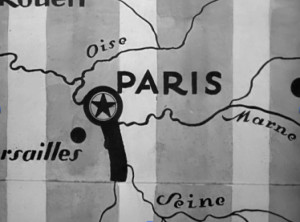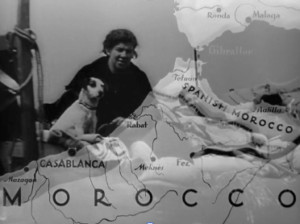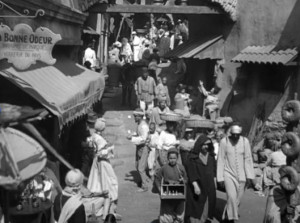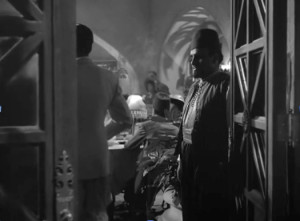Teaching Casablanca: Clay, Ink, Documentary, Set
Kyle Stevens
Students need to become acquainted with classical Hollywood, if only because the studios’ industrial and aesthetic global influence is arguably unparalleled. In fact, in order to understand so much of film history, students must apprehend the paradigmatic idea of Hollywood style against which critics and filmmakers have frequently positioned themselves in their efforts to explain or create counter movements and legacies. Yet, as with any area of film history, we should be careful not to project uniformity where it does not, and did not, exist. Students have a right to be confused, for instance, if we celebrate the individual genius of international directors and tell them that they immigrated to Hollywood, only to then define Hollywood as homogeneous. Treating Hollywood as homogenous is also dangerous if the message is that classical style is “transparent,” a style developed to reduce audiences’ requisite labor to zero. One risks implying that the style is not really there, or that it’s so well known that it becomes somehow unknowable, which leaves the style’s power ultimately intact. This not only perpetuates the exoticism of non-Hollywood styles, it suggests a lack of awareness on Hollywood’s part, as though Hollywood had no idea of itself or what it was doing (unlike so many cinematic movements, which come with their own manifestos). In turn, this can suggest that a Hollywood film cannot be art while excusing Hollywood’s ideological faults. Describing Hollywood as transparent or as “mere entertainment” or “escape” can also be infelicitous if one talks of “classical Hollywood realism,” for how can something so carefully controlled, so artificial, qualify as realism, which intuitively indicates a connection to reality?
Hence, teaching classical Hollywood can be challenging. One must impart the history of the idea of its paradigmatic style without reinforcing it. Casablanca (USA, Michael Curtiz, 1942) is perfect for this. Well-received at the time of its release, canonized by critics, lionized by Bugs Bunny, and still in the cultural atmosphere (in the US), Casablanca allows the distinction between realist and realistic to be made clear. It also exemplifies the idea of continuity editing typically attributed to the classical Hollywood period while demonstrating the depth and complexity of the style. Furthermore, it, like all films, reveals the inseparability of politics and aesthetics, though it is perhaps more surprising—and so instructive—that Casablanca encourages audiences to pay attention to formal aspects first, given that some spectators may assume its form is too basic to be remarkable.
From its opening, Casablanca invites audiences to think about realism, at the levels of both medium specificity and narrative. It begins with a shot of the world, or, rather, the notion of the world that a clay globe denotes. A masculine voice declares: “With the coming of the Second World War, many eyes in imprisoned Europe turned hopefully, or desperately, toward the freedom of the Americas.” Like the eyes mentioned, the globe also turns as the camera approaches, honing in on Europe.
During this narration, the image track cuts to an animated map, as a thick line traces the journey described.
The image track soon imposes documentary footage of mass exoduses upon the map: ocean liners sail and caravans of people, presumably exiled, tread across landscapes.
Casablanca then transitions one last time. The film arrives at a minaret, then quickly drops down, arriving in a busy market as the voiceover intones that unlike refugees lucky enough to make it to “the new world,” “the others”—which now includes us—“wait in Casablanca…and wait and wait and wait.” Coming on the heels of documentary footage, not to mention made for an audience well aware that no crew was sent to war-torn Morocco to shoot, this market is patently a movie set.
After my students and I watch the entire movie together, I return to this initial scene in class. We are only one minute and ten seconds in, and there is already a wealth of material for students to analyze. I try never to be too directive or to ask obviously leading questions, as though there might be a right thing to notice, but asking students why this story—a story made during and about war—might start this way is, I hope, a question specific enough to get the gears turning while capacious enough to allow for classroom discovery. Students may note, for example, that the globe spins from Asia to Europe, functioning not just as an establishing shot of sorts but also strengthening the sense that the Americas are the eventual destination. They may also attend to the fact that the globe is clay, a rather moving image of a world at war, comprised of nations whose borders are proving all too malleable.
As students think about the representation of the world, they might consider the sequence of the different modes for doing so in this prologue. Indeed, their order—from the relatively abstract clay and map (maps, it may be worth pointing out, usually acquire their meaning by distorting space) to the filmic capture of documentary footage of displaced people to the fictional setting—can serve to motivate a great deal of film theory, such as the criticism and scholarship which builds on Charles Sanders Peirce’s work on signs and indexicality. The prologue’s sequencing may even indicate something like a Hollywood realist manifesto: it is not through documentary but through fiction that one will learn the truth of the war. This opens up the possibility of thinking together about the nature of fiction, and how some movies—even realist ones—may deliberately choose to appear artificial, as well as the strategy of addressing expansive political and historical matters through the microcosms of affective, interpersonal stories. In thinking together about the relation of aesthetics and politics, students might observe that the documentary footage of real downtrodden people is deployed as background for a story about white Americans and Europeans, and the ensuing indictment of isolationism (an urgent view at the time of the film’s making).
I might also urge students to scrutinize the soundtrack. The music helps to establish the setting, and it is open to the charge of Orientalism. The narrator’s voice invites careful listening as his newsreel-style diction shifts once we arrive on the film’s set to a storytelling tone. It also allows students to think about the convention of the omniscient narrator, and how that sonic figure is typically masculine. (There are no female-sounding omniscient narrators in classical Hollywood history, and they remain rare today.) The voiceover’s repeated “and wait” can also encourage students to think about visual metaphor, as it accompanies the camera’s descent into the fictional world, as if this place is purgatory and neither we nor the characters are saved.
Parsing out the elements of the prologue does more than prime students to see that the mists into which Rick (Humphrey Bogart) and his newfound friend Captain Renault (Claude Rains) walk at the end of the movie are the same mists of history that spun the world forward from the beginning. It prepares them to pitch their awareness of Casablanca’s style high, and to guard against expectations that the film will be “simply” classical, or that its editing and cinematographic choices may not be important for understanding it. It prepares them, too, to see the camera-narrator in later moments of the film, as when it takes on a phenomenally human-like type of vision and movement when it introduces us to Rick’s Café Americain. After watching patrons happily flocking in from a high angle, it sinks down and ambles up to the entrance, which is held open by the doorman.
After “walking in,” the camera suddenly embarks on a tour of the club, gliding unnoticed behind the tables of chattering parties. Perhaps it shares the perspective of a wall; we’re not sure. But it is sure. It heads confidently to Sam (Dooley Wilson), a black man playing the piano, closing in on him as he sings “‘cause my hair is curly.” This presentation of supporting character Sam is usefully contrasted with the later introductions of lead protagonists Rick and Ilsa (Ingrid Bergman), who enter the frame. Sam is introduced as part of the café, and will in fact be sold with it. I doubt that I need to spell out the implications of introducing the sole African-American actor and character in this way here, but it is nonetheless crucial film grammar for students to apprehend if they are to grasp Casablanca’s politics of representation at a level beyond the narrative events that unfold.
I have concentrated on teaching Casablanca as a classical Hollywood film in a broad sense, and I hope I have shown that attending carefully to the prologue is a productive means for inviting discussion. Many, many more specific questions can be fruitfully posed of the film, and for a variety of purposes. One might, for instance, ask students to weigh in on its generic identity. Anxieties about Rick’s national allegiance and Ilsa’s romantic one must be resolved for the narrative to end, suggesting a war film or a romance, yet it visually resembles what we now dub film noir.
The case Casablanca makes for the value of classical Hollywood fiction as a form of knowledge-seeking has relevance for us as instructors, too. Casablanca’s characters want to know things. They want to know the truth, and how they feel, or should feel, about that truth. Moreover, both its narrative arc and style of performance imbue a sense of theatricality, or liveness, to this pursuit. In this way, Casablanca’s dramatic tension rests on our appetite for spontaneous revelations. There is some overlap here with the classroom, where, as teachers, we aim to excite students’ curiosity about a subject while allowing for sudden breakthroughs and rewarding tangents. Indeed, even though ensuring that a particular matter will be covered is usually the more responsible choice, students often find in-class discovery a memorable kind of interpretation. There is a frisson of excitement when minds meet in order to understand a text, a text’s relation to itself, a text’s relation to other texts, and a text’s relation to an object or idea in the world. But then learning always entails a hint of drama.
Kyle Stevens is Visiting Assistant Professor of Cinema Studies and English at Colby College. He is the author of Mike Nichols: Sex, Language, and the Reinvention of Psychological Realism (Oxford University Press), and his essays have appeared in such spaces as Cinema Journal, Critical Quarterly, Film Criticism, and World Picture, as well as several edited collections. In 2016, he will take over as editor of New Review of Film and Television Studies.





